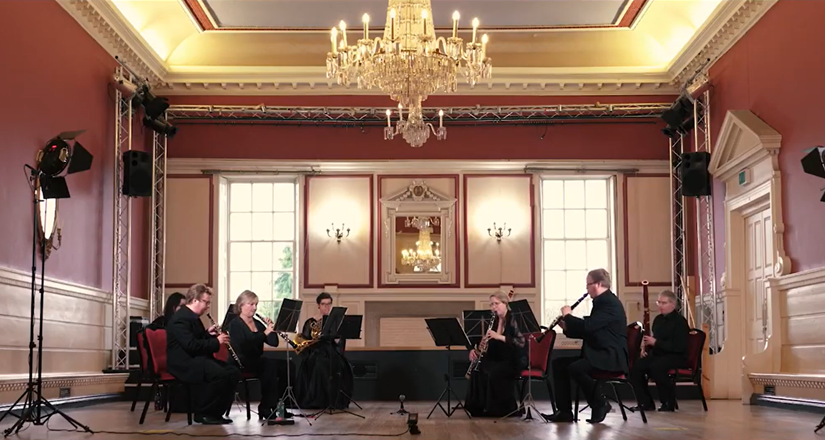
- Live Shows
- Music
- London-Serenata-Classical-Music-Concert
A selection of our online events are free to watch and take part in. If you would like to support the work that we are doing to provide arts at home, while theatres across the country are closed, you can donate here.

Classical music returns in this beautiful recorded performance, filmed specially in the ballroom at Stamford Arts Centre.
After the success of October's premiere on our Facebook and YouTube pages, we are thrilled to share a second concert from London Serenata with you all!
WATCH HERE:
Available to watch now:
Watch on Facebook Watch on YouTube
Due to overwhelmingly positive feedback, BOTH of our recorded London Serenata Classical Concerts are available to enjoy back to back on our YouTube channel, head over to our channel by clicking the link below!
“Soloistic vituosity”
The Times
“Superb playing”
Oxford Times
Programme notes:
Tristan Cox oboe
Emma Feilding oboe
Julian Sperry flute
Peter Sparks clarinet
Sarah Thurlow clarinet
Jo Withers French horn
Anna Drysdale French horn
Philip Gibbon bassoon
Damian Brassington bassoon
London Serenata is a new ensemble formed from the Garsington Opera and Glyndebourne ‘Opera on Tour’ Orchestras. Their aim is to bring all the drama and lyricism of the stage to the special intimacy of chamber music. After an acclaimed launch in October 2019, which included a sell-out concert in Oxford’s venerable Holywell Music Rooms, their progress has been interrupted by Covid-19. They are therefore delighted that we have given them the opportunity to perform together again!
This is their second concert in the Ballroom at the Stamford Arts Centre, in which they “reawaken an acoustic that has been asleep for far too long”.
Charles Gounod (1818 – 1893)
Petite Symphonie pour instruments à vent in B flat major
1. Adagio – Allegro 2. Andante cantabile (quasi adagio) 3. Scherzo. Allegro moderato
4. Finale. Allegretto
Gounod is well known for his composition of opera, of which the most famous is Faust. What is less well known is that he had a strong, possibly scandalous, connection with this country. Gounod, his wife and family took refuge in England in September 1870 during the Franco-Prussian War, as their house in St. Cloud near Paris was destroyed by the advancing Prussians. At first Gounod earned a living writing sentimental drawing room ballads, but he was soon commissioned to write a choral piece, Gallia, for the opening season at the Royal Albert Hall in 1871. The piece was a great success, and Gounod was appointed the first conductor of the Royal Albert Hall Choral Society, and awarded the Royal Philharmonic Society’s Gold Medal.
But when the war ended, Gounod’s wife and family returned to France, while he remained in London notoriously living with a singer, Georgina Weldon. She dominated him and took over his business affairs. Whilst Gounod was mild and accommodating, Mrs Weldon was headstrong and domineering. For example, she started litigation on Gounod’s behalf over royalties from his London publishers, Littletons, which she lost spectacularly, landing Gounod in debt. It was only in 1874 that Gounod managed to escape her clutches. He sent a distress signal to his friend, Gaston de Beaucourt, who came to England to help him get away. They eventually managed a hasty departure on 8 June, while Mrs Weldon was briefly away from home!
Gounod’s reputation in England remained high, and he was commissioned by the Birmingham Triennial Music Festival to write two large oratorios, La Rédemption for the 1882 festival, and Mors et vita for 1885. He was able to conduct the premiere of La Rédemption in Birmingham himself, but could not conduct the première of Mors et vita in 1885 because by then, Mrs Weldon had taken out an arrest warrant against him over an alleged libel. This ended Gounod’s connections with England; had he ever set foot on English soil again, he could have been taken into custody!
Gounod wrote this Petite Symphonie in 1885. It was commissioned by the flautist, Paul Taffanel, to be played by his Société de Musique pour Instruments à Vent, a group he had founded to revive the wind ensemble music of Mozart and Beethoven. All the concert programmes of the Société are available on the internet for research purposes and show that the vast majority of the music they played was by the great composers, Bach, Mozart, Beethoven, Weber, Schumann and Spohr. But Taffanel also commissioned new works from a large number of contemporary composers: most are unknown today and one recognises only the names of Brahms, Saint-Saens, D’Indy and, of course, Gounod. This Petite Symphonie remains one of the gems of nineteenth century wind music.
Antonin Dvořák (1841 – 1904) (arr. Clements)
Slavonic Dance in G minor, Op. 46, No. 8
Towards the end of the eighteenth century, a strong Czech nationalist movement developed amongst the intelligentsia of Bohemia with the aim of recreating a Czech national identity. The ultimate aim was to re-establish a Czech nation independent from the Austro-Hungarian Empire (the Dual Monarchy from 1867) because since the Battle of the White Mountain in 1620, the Hapsburgs had imposed, often violently, imperial rule, the German language and Austrian culture upon the Bohemians. The Czech language and Czech culture were all but eradicated.
Czech composers contributed to this national revival by setting Czech songs and using traditional Czech tunes and rhythms in their music. The best example is Má vlast ("My Homeland") by Bedřich Smetana, composed between 1874 and 1879, which portrays the history, legends and landscape of Bohemia.
Dvořák also wrote in the Czech idiom, and perhaps because of that, for the first 20 years of his career his works were rarely heard outside Bohemia. That all changed with the publication of his set of eight Slavonic Dances, Op. 46, in 1878 (of which we are hearing No. 8). A manuscript copy was seen by an influential German music critic, Louis Ehlert, who wrote a review in a Berlin newspaper, the Nationalzeitung, in November. This is an extract:
I was sitting one day in very bad humour, buried in a heap of musical novelties … when suddenly two works, by a composer [Dvořák] so far unknown to me, engrossed all my attention [the Slavonic Dances and the Moravian Duets, Op. 32]. … To put the matter shortly, here at last is a one hundred per cent natural talent. … A heavenly naturalness flows through his music … [with] not a trace of artificiality or constraint. Here we are confronted with perfected works of art … Whoever finds a jewel on the public highway is under an obligation to report his find. I beg the reader to look upon these lines from that point of view.
Within days there was a run on the music shops for copies of the Slavonic Dances. That Christmas, the dances were being played in concert halls and family drawing rooms throughout Europe, and Dvořák’s reputation was made.
More in Live Shows...
-
Kathryn Tickell & The Darkening

Sat 28 Feb 2026
Named after the old Northumbrian word for twilight, ‘The Darkening’ is made up o...
-
Cri du Canard: French Bal

Sat 3 Jan 2026
New Year French Bal with Cri du Canard at Stamford Arts Centre Ballroom. Cri du Canard are a French folk trio...
-
ALEX CLARKE - STAMFORD JAZZ

Fri 6 Feb 2026
As a finalist in the BBC Young Jazz Musician of the Year 2020, winner of the Ris...
-
BRYAN CORBETT QUINTET - STAMFORD JA...

Fri 9 Jan 2026
Experience the unmistakable sound of Blue Note Records - raw, soulful, and swing...
-
Romance & Revolution - Stamford Cha...

Sat 31 Jan 2026
Experience an unforgettable evening of passion and drama with this captivating p...
-
The Doric String Quartet 2026

Sat 7 Mar 2026
The Doric String Quartet brings elegance and intimacy both to the Classical cano...
-
Nordic Serenades - Stamford Chamber...

Sat 21 Mar 2026
Journey through the enchanting landscapes of Nordic music in this atmospheric co...
-
Dean Friedman

Fri 24 Apr 2026
Hailed by critics and fans alike as a one of the finest songwriters of his generation, Dean Friedman has achie...








